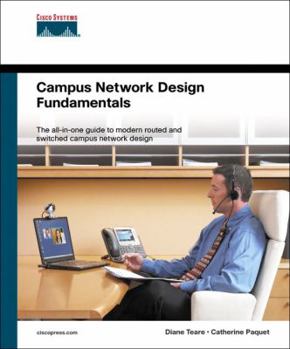Campus Network Design Fundamentals
Select Format
Select Condition 
Book Overview
The all-in-one guide to modern routed and switched campus network design Understand the network design process and network design models Learn how switches are used in network design Design an IP... This description may be from another edition of this product.
Format:Paperback
Language:English
ISBN:1587052229
ISBN13:9781587052224
Release Date:December 2005
Publisher:Cisco Press
Length:378 Pages
Weight:1.50 lbs.
Dimensions:1.0" x 7.5" x 9.0"
Customer Reviews
2 ratings
Great Overview of Converged Networks Technlogies
Published by Thriftbooks.com User , 18 years ago
Campus Network Design Fundamentals (ISDN 1-58705-222-9) by Diane Teare and Catherine Paquet is an introductory to mid-level book on converged network design technologies. The book covers a wide range of technologies found in today's networks including basic routing and switching, VoIP, wireless, and QoS amongst others. One of the problems with writing such a book is that the list of topics to cover is so large that it is not possible to present any one of them in great detail. As such, the authors have a difficult task of maintaining the balance between too much detail and a glossy, marketing-type of coverage of the topics. In this particular case, the authors manage to tread this fine line with great effectiveness. The topics are covered in good-enough detail to make the material useful and informative for all readers while maintaining balance and cohesiveness in the presentation of all of the topics so as to not lose anyone in the process. The overall organization of the book lends itself to a logical flow of information. It starts with the general design process for building information networks, followed by presentation of technologies used in these networks, and finally ending with practical design examples to illustrate these topics. This allows the reader to grasp the information in a modular fashion, building on the previous knowledge as you progress through the book. The other thing to note is that the authors are not afraid to get into details when such details are necessary. The chapter dealing with QoS is a good example of this. The authors dissect the TOS field in the packet header in some detail. Another example is the VoIP chapter which presents some interesting information about compression schemes and capacity calculations for IP telephony. The final chapters present a case study where all of the previously learned concepts are put to use in designing a network for a hypothetical firm. These chapters translate into an excellent summary of the material presented in the previous chapters. Experienced readers may find some of the information in the book to be introductory but that is due to the nature of the material being presented. For example, the information relating to switching and routing is basic due to the fact that it is a well established technology and most people working in the networking arena are experienced with it. VoIP on the other hand is new and as such may come across as new information. To the authors' credit, they present the more well-known topics before the less well-known ones. This book should serve as a good, solid primer on converged network technologies. Within the past couple of years, networking technology is making a concerted shift towards unification of communication needs including voice, data, and video. This book presents a comprehensive overview of the technologies used to make this shift possible. I highly recommend this to anyone involved in designing, implementing, or managing conver
What You Can Do and How to Do It.
Published by Thriftbooks.com User , 18 years ago
It used to be so simple, you had a campus, perhaps a university, perhaps industrial. You needed phones and the like, you called the phone company, had a few meetings and everything was done. No more. Now we have convergence. Every office, nearly every person has specialized communications requirements from standard phone to broadband. This book is intended for the person newly assigned to setting up the communcations for a campus. It talks about what you can do, what you can offer to your client/customers, and then goes into the technology that you will need to make all of this happen. Every aspect of modern communications is covered from the basic network that you will need to set up to handling long distance communications using VoIP rather than the much more expensive switched circuit technology. The book covers the technology from both the technical standpoint of what it needs to do and from the standpoint of what hardware is available to make it all come together. Obviously this book is quite oriented to Cisco hardware (it's published by Cisco Press) but much of the same capability will be needed regardless of the manufacturer.




